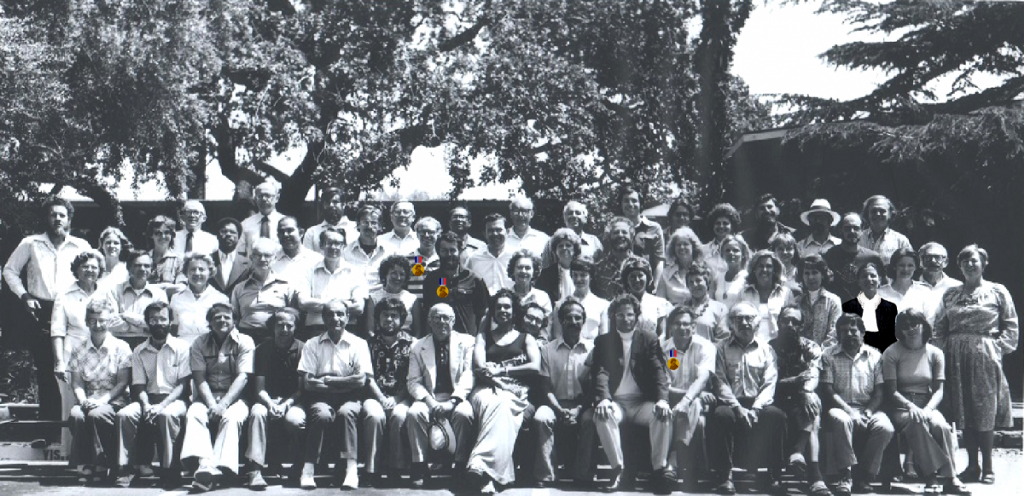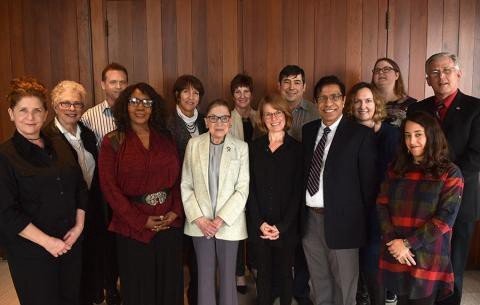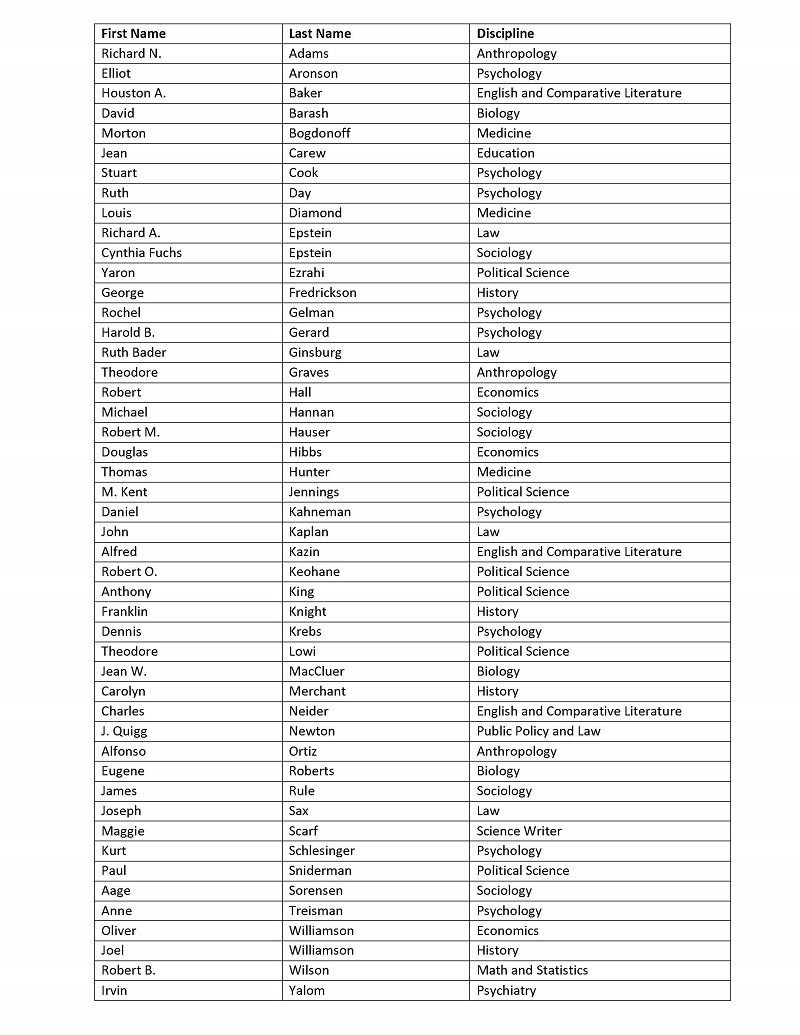Three Nobels, a Supreme, and More
Submitted by medium on Sat, 06/19/2021 - 12:57
The Center is known for hosting many of the deepest thinkers across the social sciences and adjacent disciplines since its inaugural 1954–55 year. Each fellows class is deserving of its own spotlight, as each has been comprised of scholars who have advanced our collective understanding on questions of societal importance, in many cases garnering awards and honors for their individual achievements and contributions.
That said, the 1977–78 CASBS class is ridiculous.
In early September 1977, when the class arrived, the U.S. and Panama just signed the Panama Canal treaties. The U.S. Department of Energy had just been created. The Voyager spacecraft launched on its way to Jupiter. The final episode of “The Mary Tyler Moore Show” aired, while Cheryl Ladd replaced Farrah Fawcett on “Charlie’s Angels.” Chris Evert had just won her third straight U.S. Open. The Atari 2600 video game system made its debut in North America. The funky disco tune “Best of My Love” by The Emotions sat atop the Billboard 100 chart but, really, that must have been a cry for help after the death of Elvis Presley in mid-August.
And, notably, the 1977 fall harvest was rated a “classic vintage” for port wines — as well as social scientists at CASBS.
Who at the time could have known that this class contained three — three — future Nobel Prize winners and a Supreme Court Justice?

The 1977–78 CASBS fellows class. We help identify the three future Nobel Prize winners and the future Supreme Court Justice.
Daniel Kahneman was a fellow in the 1977–78 class. We expect you know that, as most followers of the Center have learned, here or elsewhere, that Richard Thaler made his infamous pilgrimage to the CASBS hill in 1977 to seek out Kahneman and his nearby collaborator, Amos Tversky, and figure out whether he wanted to pursue a research agenda in which new psychology insights collided with economic theory. (It turned out rather well for Thaler, himself a future CASBS fellow and Nobel Prize winner.) Kahneman went on to win a Nobel Prize in economic sciences in 2002, cited “for having integrated insights from psychological research into economic science, especially concerning human judgment and decision-making under uncertainty.”
The article that Kahneman finished with Tversky at CASBS that year, “ Prospect Theory: An Analysis of Decision under Risk,” published in Econometrica in 1979, is widely viewed as the cornerstone of a body of work that earned Kahneman the Nobel Prize in economics in 2002. It is one of the most cited articles in social science. In his end-of-fellowship memo to CASBS director Gardner Lindzey, he confirmed it as “the most significant ‘tangible’ achievement of the year.”
He also noted that “while the year was not particularly notable for the amount of writing that got done, it was rather better in terms of the amount of thinking, and in preparing for future work.”
Kahneman is the Eugene Higgins Professor of Psychology, Emeritus, and Professor of Psychology and Public Affairs, Emeritus, at Princeton University.
Oliver Williamson was a fellow in the 1977–78 class. He won a Nobel Prize in economic sciences in 2009, cited “for his analysis of economic governance, especially the boundaries of the firm.” During his CASBS year he worked on several pieces of scholarship, two of which are now considered classics with enduring influence: his 1979 article, “Transaction-Cost Economics: The Governance of Contractual Relations,” published in The Journal of Law & Economics, and his 1985 book The Economics Institutions of Capitalism: Firms, Markets, Relational Contracting. A copy of the book resides in the Center’s Ralph W. Tyler Collection.
In an end-of-fellowship memo to CASBS director Gardner Lindzey dated June 2, 1978, without flourish Williamson reported that he “received useful advice on various research matters from Louis Diamond, Richard Epstein, Robert Hall, Michael Hannan, Daniel Kahneman, John Kaplan, and Joseph Sax.”
Williamson died in May 2020 in nearby Oakland, CA. He was the Edgar F. Kaiser Professor, Emeritus, of Business, Economics, and Organization at the University of California, Berkeley.
Robert B. Wilson was a fellow in the 1977–78 class. He won a Nobel Prize in economic sciences in 2020, cited “for improvements to auction theory and inventions of new auction formats.” During his CASBS year he worked on at least one important piece of scholarship that contributed to the body of work that earned him the award — his 1979 article, “Auctions of Shares,” published in The Quarterly Journal of Economics.
In his end-of-fellowship memo to CASBS director Gardner Lindzey in 1978, Wilson expressed appreciation that the CASBS hill afforded, perhaps compared with the main campus below of Stanford, his home institution: “The opportunities were exactly what I wanted — quiet time for research and reading in areas of my interests. The facilities, library, staff, computer, etc. were perfectly suited.”
Wilson is The Adams Distinguished Professor of Management, Emeritus, at Stanford University.
As a postscript to this serendipity of three future Nobelists in the same class, it is worth noting that both Kahneman and Wilson shared the Nobel Prize with other CASBS fellows. In 2002, Kahneman shared the prize with 1972–73 CASBS fellow Vernon L. Smith; in 2020, Wilson shared the prize with Paul Milgrom, a two-time CASBS fellow in 1991–92 and 1998–99. Milgrom and Wilson are the 28th and 29th CASBS fellows to win a Nobel. View the full list.
Ruth Bader Ginsburg was a fellow in the 1977–78 class, in residence for the second half of the academic year. Though Ginsburg reached the wider public consciousness in 1993, when she was nominated for the U.S. Supreme Court, by 1977 she already had cemented her place in history. She was the first tenured female faculty member at Columbia University Law School, as well was founder and general counsel of the Women’s Rights Project at the American Civil Liberties Union. In her role directing that project, Ginsburg argued six gender discrimination cases before the Supreme Court in the 1973–76 period, winning five of them. By the time she reached CASBS, she already was credited as the leading legal advocate on behalf of women’s rights in the United States.
Though there is no record that she submitted an end-of-year fellowship memo or evaluation, Ginsburg interestingly speculated, in a letter to CASBS dated May 24, 1976, on what her research activities during her upcoming fellowship might include. It reflected the shifting social landscape of the time:
I anticipate pursuing a writing project relating the contemporary feminist movement to other movements for change in American Society, but would like to reserve decision on precise definition until next year, when returns should be clearer on the equal rights amendment and precedent evolving in the Supreme Court.
RBG did work on at least one significant piece of scholarship during her CASBS year — “Sex Equality and the Constitution,” a 1978 lecture later published in the Tulane Law Review. A short time later, in 1980, she was nominated (by President Jimmy Carter) and appointed to the U.S. Court of Appeals for the District of Columbia Circuit, where she served until her nomination and appointment to the U.S. Supreme Court.
Notably, RBG returned to CASBS in February 2017, 40 years after her fellowship. She had lunch with fellows and staff, participated in a Q&A session, and even revisited her fellowship study (#35). It was a private, not public, gathering; regrettably CASBS was not permitted to publicize it. But RBG was a good sport and posed for a series of photos, including one with many of the CASBS staff.

Ruth Bader Ginsburg died in September 2020.
Ginsburg, Kahneman, Williamson, Wilson. Impressive. And pretty cool. But too bad there aren’t Nobel Prizes for the other social sciences! For example, in 2005, Robert Keohane, a fellow in the 1977–78 CASBS class (and again in 1987–88 and 2004–05, and a current CASBS research affiliate), won the Johan Skytte Prize in Political Science, considered by many the Nobel-equivalent for that discipline.
Whether individually or as a collective, the 1977–78 class was formidable. Of 48 fellows in the class, a remarkable 25 were elected to the American Academy of Arts and Sciences; nine were elected to the National Academy of Sciences; 14 of them earned 17 Guggenheim Fellowships; three were elected Distinguished Fellows of the American Economic Association; three won the William James Award for Lifetime Achievement from the Association for Psychological Science; two were elected to the American Philosophical Society; one, Alfonso Ortiz, won a MacArthur Foundation Fellowship (the ‘genius award’); one, Anne Treisman, received the National Medal of Science; and one, Daniel Kahneman, was awarded the Presidential Medal of Freedom. And these are just some of the higher profile awards and honors the Center tracks.
And we should not let future Nobel Prizes and Supreme Court appointments obscure the fact that some incredible scholarship in book form was produced (at least partially) by the 1977–78 CASBS class. Here is a sampling of books, copies of which reside in the Center’s Ralph W. Tyler Collection — which means they were initiated, worked on, or completed at CASBS during the 1977–78 fellowship year:
Houston Baker, Jr.’s breakthrough book, The Journey Back: Issues in Black Literature and Criticism (1980)
David Barash’s The Whisperings Within: Evolution and the Origin of Human Nature (1979) — translated into seven languages
George M. Frederickson’s White Supremacy: A Comparative Study in American and South African History (1981), a Pulitzer Prize finalist in 1982
Robert Keohane’s classic After Hegemony: Cooperation and Discord in the World Political Economy (1984), for which he was awarded the Grawemeyer Award for “ideas improving world order”
Though originally published in 1969, Theordore Lowi’s second edition of The End of Liberalism: The Second Republic of the United States (1979) was substantially revised to include the political developments of the 1970s, ensuring its status as “a modern classic of political science”
Carolyn Merchant’s The Death of Nature: Women, Ecology and the Scientific Revolution (1980) vaulted Merchant to the forefront in the movement to emphasize gender in the historiography of modern science; the book is considered groundbreaking “due to her connection between feminization of nature and the naturalization of women.” Celebrating the 40th anniversary of its publication in 2020, The Death of Nature will be the focus of an essay reflecting upon its enduring influence as part of CASBS’s partnership with Public Books.
Maggie Scarf’s Unfinished Business: Pressure Points in the Lives of Women (1980), was the first best-seller in her series of books and other writings on women, family relationships, and marriage
Irvin Yalom’s Existential Psychotherapy (1980) advanced his model of the human condition and the ways people respond to their conditions, and is “recognized as having greatly influenced the development of existential thinking and practice among American psychotherapists”
We’re cherry-picking from a longer list of books, and surely others by members of the 1977–78 class are worthy of mention (check for yourself here). Moreover, a focus on books ignores influential articles that fellows from this remarkable CASBS class certainly wrote or worked on during their fellowship year.
But, even without going there, this surely was one of the most remarkable groups of social scientists assembled in one place at one time. A classic vintage.
The 1977–78 CASBS class:

Written by Mike Gaetani
Jason Gonzalez and Ting Liu contributed to this article.
Graphics: Paola Dios
Read More Link:
